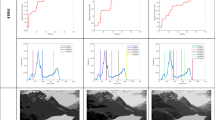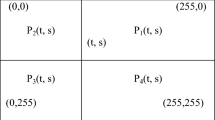Abstract
The segmentation of digital images is an open problem that has increasingly attracted the attention of researchers during the last years. Thresholding approaches are often used due to their independence from the resolution of the images and their speed. However, simple thresholding approaches usually generate low-quality images. To achieve a better balance between speed and quality, many criteria are used to select the thresholds that segment the image. The type II fuzzy entropy (TII-FE) was introduced to perform image thresholding by modeling the classes of an image as membership functions to avoid uncertainty on the selection of the thresholds leading to improvement regarding the quality of the segmented image. To maximize the TII-FE, an efficient optimizer should be used to converge quickly to the optimal. In this paper, a hybrid method based on the Paddy Field Algorithm (PFA) and the Plant Propagation Algorithm (PPA) with the disruption operator (HPFPPA-D) is presented for the maximization of the TII-FE. The hybridization of these algorithms is used to enhance the performance of each algorithm by introducing operators from other approaches. In this case, the PFA shows good exploitation features that are complemented by the exploration behavior of PPA and refined with the disruption operator. The synergy between those methods has led to an accurate methodology for TII-FE thresholding. The proposed HPFPPA-D for TII-FE is evaluated using a set of benchmark images regarding convergence and image quality. The results are compared against other state-of-the-art evolutionary algorithms providing evidence of a superior and significant performance.






Similar content being viewed by others
Explore related subjects
Discover the latest articles, news and stories from top researchers in related subjects.References
Agrawal S, Panda R, Bhuyan S, Panigrahi BK (2013) Tsallis entropy based optimal multilevel thresholding using cuckoo search algorithm. Swarm Evol Comput 11:16–30. https://doi.org/10.1016/j.swevo.2013.02.001
Akyol S, Alatas B (2017) Plant intelligence based metaheuristic optimization algorithms. Artif Intell Rev 47:417–462. https://doi.org/10.1007/s10462-016-9486-6
Benzid R, Arar D, Bentoumi M (2008) A fast technique for gray level image thresholding and quantization based on the entropy maximization. In: 5th international multi-conference on systems, signals and devices. IEEE, Amman, pp 1–4
Bhandari AK, Kumar A, Singh GK (2015a) Tsallis entropy based multilevel thresholding for colored satellite image segmentation using evolutionary algorithms. Expert Syst Appl 42:8707–8730. https://doi.org/10.1016/j.eswa.2015.07.025
Bhandari AK, Kumar A, Singh GK (2015b) Modified artificial bee colony based computationally efficient multilevel thresholding for satellite image segmentation using Kapur’s, Otsu and Tsallis functions. Expert Syst Appl 42:1573–1601
Burman R, Paul S, Das S (2013) A differential evolution approach to multi-level image thresholding using type II fuzzy sets. Lecture Notes in Computer Science (including subseries lecture notes in artificial intelligence and lecture notes in bioinformatics), LNCS, vol 8297, pp 274–285. https://doi.org/10.1007/978-3-319-03753-0_25
Castillo O, Sanchez M, Gonzalez C, Martinez G (2017) Review of recent type-2 fuzzy image processing applications. Information 8:97. https://doi.org/10.3390/info8030097
García S, Molina D, Lozano M, Herrera F (2009) A study on the use of non-parametric tests for analyzing the evolutionary algorithms’ behaviour: a case study on the CEC 2005 special session on real parameter optimization. J Heuristics 15:617–644. https://doi.org/10.1007/s10732-008-9080-4
Gonzalez RC, Woods RE (1992) Digital image processing. Prentice-Hall, Upper Saddle River, NJ
Horng M-H, Liou R-J (2011) Multilevel minimum cross entropy threshold selection based on the firefly algorithm. Expert Syst Appl 38:14805–14811. https://doi.org/10.1016/j.eswa.2011.05.069
Kapur JN, Sahoo PK, Wong AKC (1985) A new method for gray-level picture thresholding using the entropy of the histogram. Comput Vis Graph Image Process 29:273–285
Kennedy J, Eberhart RC (1995) Particle swarm optimization. In: International conference on neural networks, 1995 proceedings, vol 4, pp 1942–1948. https://doi.org/10.1109/icnn.1995.488968
Kong X, Chen Y-L, Xie W, Wu X (2012) A novel paddy field algorithm based on pattern search method. In: Proceedings of the international conference on information and automation, pp 686–690
Kumar S, Kumar P, Sharma TK, Pant M (2013) Bi-level thresholding using PSO, artificial bee colony and MRLDE embedded with Otsu method. Memet Comput 5:323–334. https://doi.org/10.1007/s12293-013-0123-5
Lan S, Li LIU, Kong Z, Wang JG (2010) Segmentation approach based on fuzzy Renyi entropy
Li CH, Lee CK (1993) Minimum cross entropy thresholding. Pattern Recognit 26:617–625. https://doi.org/10.1016/0031-3203(93)90115-D
Liu H, Ding G, Wang B (2014) Bare-bones particle swarm optimization with disruption operator. Appl Math Comput 238:106–122. https://doi.org/10.1016/J.AMC.2014.03.152
Mafarja MM, Mirjalili S (2017) Hybrid whale optimization algorithm with simulated annealing for feature selection. Neurocomputing 260:302–312. https://doi.org/10.1016/J.NEUCOM.2017.04.053
Martin D, Fowlkes C, Tal D, Malik J (2001) A database of human segmented natural images and its application to evaluating segmentation algorithms and measuring ecological statistics. In: Proceedings eighth IEEE international conference on computer vision, ICCV 2001, vol 2, pp 416–423. https://doi.org/10.1109/ICCV.2001.937655
Miao Q, Xu P, Liu T et al (2015) A novel fast image segmentation algorithm for large topographic maps. Neurocomputing 168:808–822. https://doi.org/10.1016/j.neucom.2015.05.043
Mostafa A, Hassanien AE, Houseni M, Hefny H (2017) Liver segmentation in MRI images based on whale optimization algorithm. Multimed Tools Appl. https://doi.org/10.1007/s11042-017-4638-5
Oliva D, Cuevas E, Pajares G et al (2013) Multilevel thresholding segmentation based on harmony search optimization. J Appl Math. https://doi.org/10.1155/2013/575414
Oliva D, Cuevas E, Pajares G et al (2014) A multilevel thresholding algorithm using electromagnetism optimization. Neurocomputing 139:357–381
Oliva D, Osuna-Enciso V, Cuevas E et al (2015) Improving segmentation velocity using an evolutionary method. Expert Syst Appl. https://doi.org/10.1016/j.eswa.2015.03.028
Otsu N (1979) A threshold selection method from gray-level histograms. IEEE Trans Syst Man Cybern 9:62–66. https://doi.org/10.1109/TSMC.1979.4310076
Ouadfel S, Taleb-Ahmed A (2016) Social spiders optimization and flower pollination algorithm for multilevel image thresholding: a performance study. Expert Syst Appl 55:566–584. https://doi.org/10.1016/j.eswa.2016.02.024
Premaratne U, Samarabandu J, Sidhu T (2009) A new biologically inspired optimization algorithm. In: 2009 International conference on industrial and information systems (ICIIS). IEEE, pp 279–284
Riomoros I, Pajares G, Herrera PJ et al (2010) Automatic image segmentation of greenness in crop fields. In: Proceedings of the 2010 international conference on soft computing and pattern recognition, SoCPaR 2010, pp 462–467. https://doi.org/10.1109/SOCPAR.2010.5685936
Sahoo PK, Arora G (2004) A thresholding method based on two-dimensional Renyi’s entropy. Pattern Recognit 37:1149–1161. https://doi.org/10.1016/j.patcog.2003.10.008
Sahoo P, Soltani S, Wong AK (1988) A survey of thresholding techniques. Comput Vis Graph Image Process 41:233–260. https://doi.org/10.1016/0734-189X(88)90022-9
Salhi A, Fraga ES (2011) Nature-inspired optimisation approaches and the new plant propagation algorithm, pp 1–8
Sarafrazi S, Nezamabadi-pour H, Saryazdi S (2011) Disruption: a new operator in gravitational search algorithm. Sci Iran 18:539–548. https://doi.org/10.1016/J.SCIENT.2011.04.003
Sarkar S, Das S, Chaudhuri SS (2012) Multilevel image thresholding based on Tsallis entropy and differential evolution. In: Swarm, evolutionary, and memetic computing, SEMCCO 2012
Sathya PD, Kayalvizhi R (2011) Optimal multilevel thresholding using bacterial foraging algorithm. Expert Syst Appl 38:15549–15564. https://doi.org/10.1016/j.eswa.2011.06.004
Storn R, Price K (1997) Differential evolution—a simple and efficient heuristic for global optimization over continuous spaces. J Glob Optim 11:341–359
Talbi E-G (2002) A taxonomy of hybrid metaheuristics. J Heuristics 8:541–564. https://doi.org/10.1023/A:1016540724870
Talbi E-G (2009) Metaheuristics: from design to implementation, 1st edn. Wiley, New York
Tao WB, Tian JW, Liu J (2003) Image segmentation by three-level thresholding based on maximum fuzzy entropy and genetic algorithm. Pattern Recognit Lett 24:3069–3078. https://doi.org/10.1016/S0167-8655(03)00166-1
Tian W, Geng Y, Liu J, Ai L (2009) Maximum fuzzy entropy and immune clone selection algorithm for image segmentation. In: 2009 Asia-Pacific conference on information processing. IEEE, Shenzhen, pp 38–41
Tizhoosh HR (1998) Fuzzy image processing (in German). Springer, Berlin
Tizhoosh HR (2005) Image thresholding using type II fuzzy sets. Pattern Recognit 38:2363–2372. https://doi.org/10.1016/j.patcog.2005.02.014
Tizhoosh HR (2008) Type II fuzzy image segmentation. Stud Fuzziness Soft Comput 220:607–619. https://doi.org/10.1007/978-3-540-73723-0_31
Wang Z, Bovik AC, Sheikh HR, Simoncelli EP (2004) Image quality assessment: from error visibility to structural similarity. IEEE Trans Image Process 13:600–612. https://doi.org/10.1109/TIP.2003.819861
Zhao M, Fu AMN, Yan H (2001) A technique of three-level thresholding based on probability partition and fuzzy 3-partition. IEEE Trans Fuzzy Syst 9:469–479. https://doi.org/10.1109/91.928743
Acknowledgements
None of the authors of this paper have a financial or personal relationship with other people or organizations that could inappropriately influence or bias the content of the paper.
Author information
Authors and Affiliations
Corresponding author
Ethics declarations
Conflict of interest
It is to specifically state that “No Competing interests are at stake and there is No Conflict of Interest” with other people or organizations that could inappropriately influence or bias the content of the paper.
Human and animal rights
This article does not contain any studies with human participants or animals performed by any of the authors.
Additional information
Communicated by V. Loia.
Publisher's Note
Springer Nature remains neutral with regard to jurisdictional claims in published maps and institutional affiliations.
Rights and permissions
About this article
Cite this article
Abd Elaziz, M., Sarkar, U., Nag, S. et al. Improving image thresholding by the type II fuzzy entropy and a hybrid optimization algorithm. Soft Comput 24, 14885–14905 (2020). https://doi.org/10.1007/s00500-020-04842-7
Published:
Issue Date:
DOI: https://doi.org/10.1007/s00500-020-04842-7




